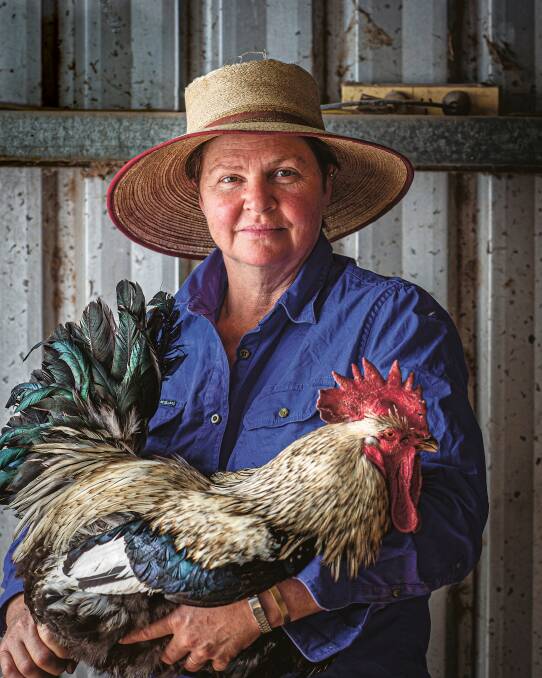
Grant Hilliard was an aspiring filmmaker, working in restaurants as a manager and sommelier to make ends meet. About 15 years ago it dawned on him there was something peculiar about the fact that wines were justly fussed over for their pedigree, genetics and terrier, but meat was largely generic, regardless of the breed or production method or place..
Subscribe now for unlimited access.
or signup to continue reading
With a burgeoning interest in sustainable agriculture, a passion for artisan culture and a courage borne of ignorance, he found some farmers growing rare breeds of sheep and some chefs willing to buy their lambs ... and Feather and Bone - rare breed providore and whole animal butchery was born.
A few years later his partner Laura Dalrymple joined the team and the search for farmers who were prioritising a long-term holistic philosophy intensified.
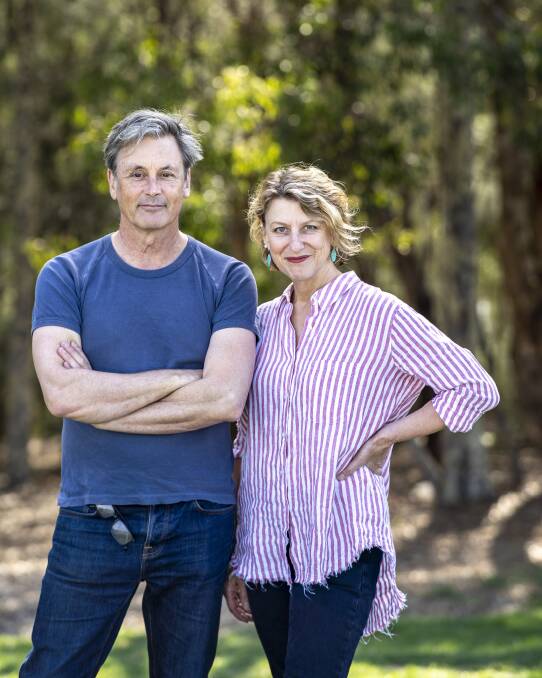
Feather and Bone's own philosophy runs parallel: their goal is to for everyone to only eat meat that comes from pasture-raised animals grown on regenerative farms that contribute to the overall health of the planet.
"We are all inextricably linked in a vast, natural community, and every step that each of us takes - no matter how large or small - towards a more considered and beneficial relationship with nature is good for everyone else," they write in The Ethical Omnivore: A practical guide and 60 nose-to-tail recipes for sustainable meat eating (Murdoch Books, $39.99).
It's science-focussed, but flavoured with a large dose of love - for animals, the land, and the environment.
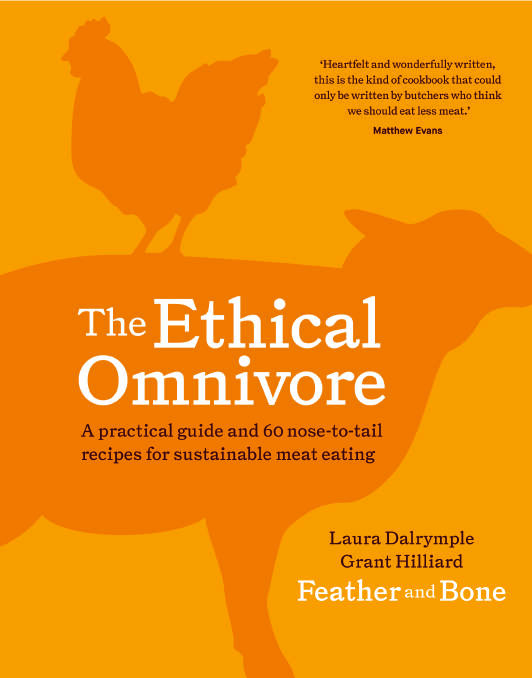
"When it comes to the way our food is produced, we do have a choice," they write. "We just don't have to swallow what is served up.
"We can start demanding more transparency and accountability from the people selling our food - whether it's plant or animal based - and spend our money supporting agricultural systems that match our views and beliefs. We can eat a little less meat with a little more provenance - and we can cook together more, gathering around the table and building our own diverse, resilient and vital communities."
What follows are some profiles of producers Feather and Bone supports and some recipes using their produce.
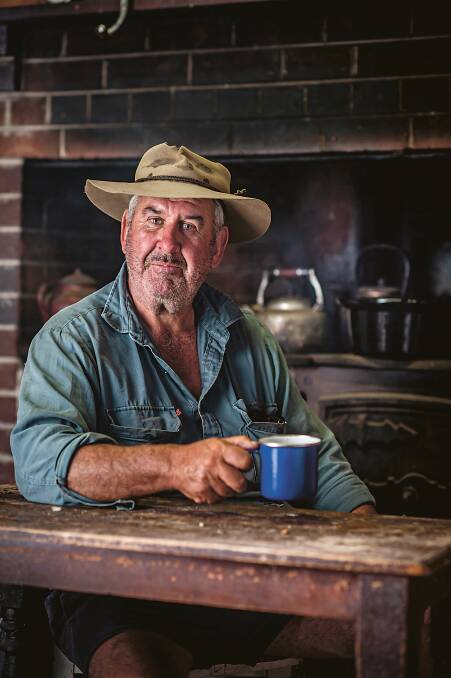
The loam and the fishes
Vince Heffernan is rare among Australian farmers for several reasons. He's the sixth generation of his family to manage Moorlands, 3000 acres on the Lachlan River, near Dalton, an hour or so out of Canberra.
That's a blink of an eye compared to the millennia of Indigenous Australian land management, but a long time in European settler history. However, while Vince continues the family business of raising livestock on his gently undulating pastures, every other aspect of his farm management is dramatically different from his forebears.
Instead of automatically prioritising human goals above all else and placing himself unassailably at the centre of his universe, Vince takes an "ecocentric" rather than "egocentric" approach to managing his land. Vince's requirement to earn an income from his land is equal in importance to the needs of all the other plants and animals.
As custodian of his land, it is his obligation to nurture the long-term health of the entire community of creatures within the farm. So, in addition to growing the excellent, award-winning Texel lambs that we've been buying seasonally for 10 years, Vince and Janet Heffernan, a horticulturalist, have spent two decades regenerating their Demeter-certified biodynamic farm in an effort to restore the necessary diversity required to create capacity and health all round. The results are inspiring.
During our visits over the past 10 years in different seasons and conditions, we've observed a profoundly different approach at work on other farms in the area: over-grazed paddocks that looked like stubbled moonscapes of compacted, bare earth interrupted by jagged erosion canyons, with few trees or shrubs, and dotted with hollow-flanked cattle searching for food. The local Lachlan River course is denuded of plants, collapsing in on itself and choking with silt. By comparison, at Moorlands, the cardinal regenerative rule of never baring the earth dictates a judicious grazing program that sees sheep constantly rotated through pastures.
Years of carefully considered native tree and shrub plantings across the property aid water retention, improve organic matter and provide habitats that have attracted the return of birds and other creatures that haven't been seen in the area for many years.
The Heffernans' stretch of Lachlan River frontage is dense with reintroduced endemic plants, and the regular deep pools that would once have provided critical habitats for diverse aquatic creatures and encouraged healthy water flow are forming again in the river course.
But the most striking expression of the "ecocentric" management practice at this sixth-generation sheep farm is the fish sanctuary. The sanctuary is a secluded dam, fringed with local aquatic plants, propagated and carefully transplanted, and is dedicated to the rehabilitation of the critically endangered Southern Pygmy Perch, whose habitat is disappearing because of the damage caused by agricultural mismanagement of the Lachlan River catchment.
Many would view the Heffernans' decision to spend a lot of money and time building a dam, fencing it off, planting it out with appropriate species and managing it as a wildlife reserve for an endangered local fish as sheer lunacy - particularly because there's no expectation of earning a return from it, beyond the satisfaction of helping to save a species and contributing to a diverse ecosystem of communities.
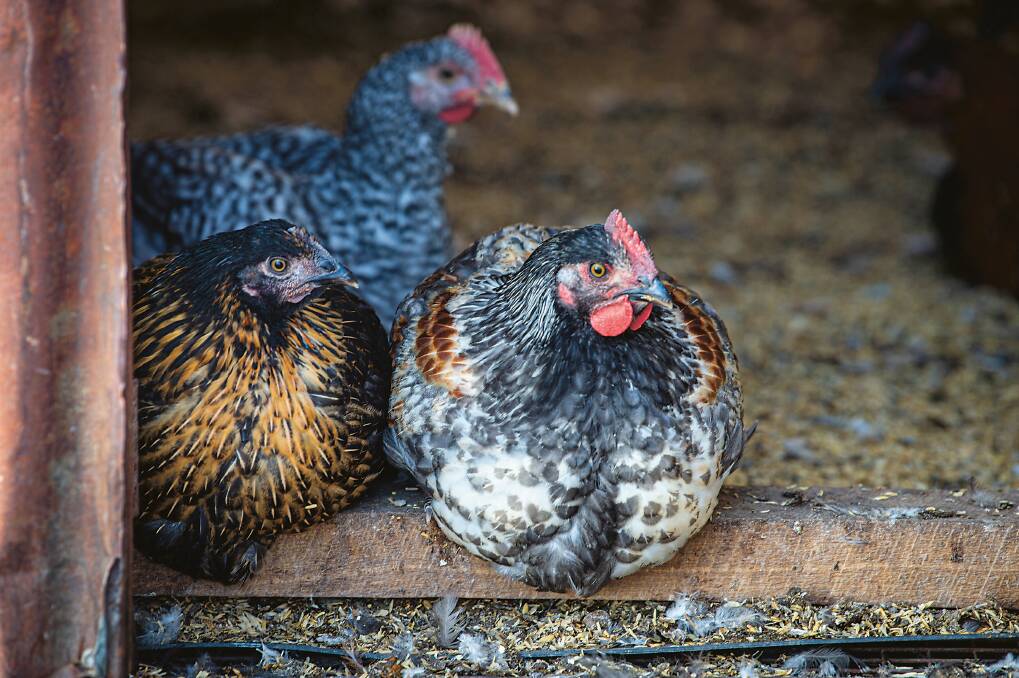
A chicken revolution
Slower-growing, athletic and selectively bred over 15 years to thrive outside in the Australian climate, Sommerlad chickens happily manage the full spectrum of extreme summer heat and mid-winter cold with resilient equanimity.
Unlike the white broiler chickens that struggle to remain agile after eight weeks of age, let alone cross the road, Sommerlad birds are a riot of colour and are built to run, hunt and explore with long, strong legs and powerful feet.
After hatching, the downy chicks spend two to three weeks in the brooder growing protective feathers, before spending the next nine to 12 weeks outside on pasture.
By contrast, the majority of white broiler chickens are bred and hatched at facilities owned by the small handful of vertically integrated poultry producers that dominate the industry.
The day-old chicks are then distributed to hundreds of farms where they grow, mostly in sheds, until they reach market weight. It's extremely rare for chicken farmers to breed and hatch their own birds.
Michael Sommerlad, the chicken expert and breeder responsible for the eponymous bird, was spurred into action by the experience of spending years in the meat-chicken industry managing "standard broiler" birds with most of the "chicken-ness" bred out of them.
In the 1990s, the white broiler took over completely, and producers sold off all other strains of meat chickens to concentrate production on this single breed.
Concerned about the loss of genetics (and knowledge), Michael purchased some of the birds that were suddenly homeless and continued to breed and foster these strains.
Convinced that Australians would embrace a better alternative if they experienced it, Michael and Kathryn Sommerlad set about producing a slow-growing, flavoursome table bird.
As well as delivering a multi-award-winning table bird with darker, deeply flavoured meat, thicker skin and golden fat, there's the skill it takes to breed and cross multiple generations of different breeding flocks to maximise the most desirable qualities to produce birds that are, literally, made for Australian pastures.
It's one thing to grow some heritage-breed chickens; it's another thing altogether to breed new strains of chickens that can be reproduced consistently and at some scale in pasture-based production.
Then there are the handful of carefully selected, family-run farms that are breeding and raising the birds according to specific Sommerlad guidelines. Each farm is unique, but all are united by a profound commitment to diversity, and all are passionate, skilful trailblazers in small-scale, regenerative farming. Whether you eat meat or not, in our humble opinion the whole country owes a debt of gratitude to the Sommerlads for their remarkable work in reintroducing critical genetic diversity to the meat chicken industry, and to the small group of farmers with the courage and imagination to embrace the Sommerlad bird.
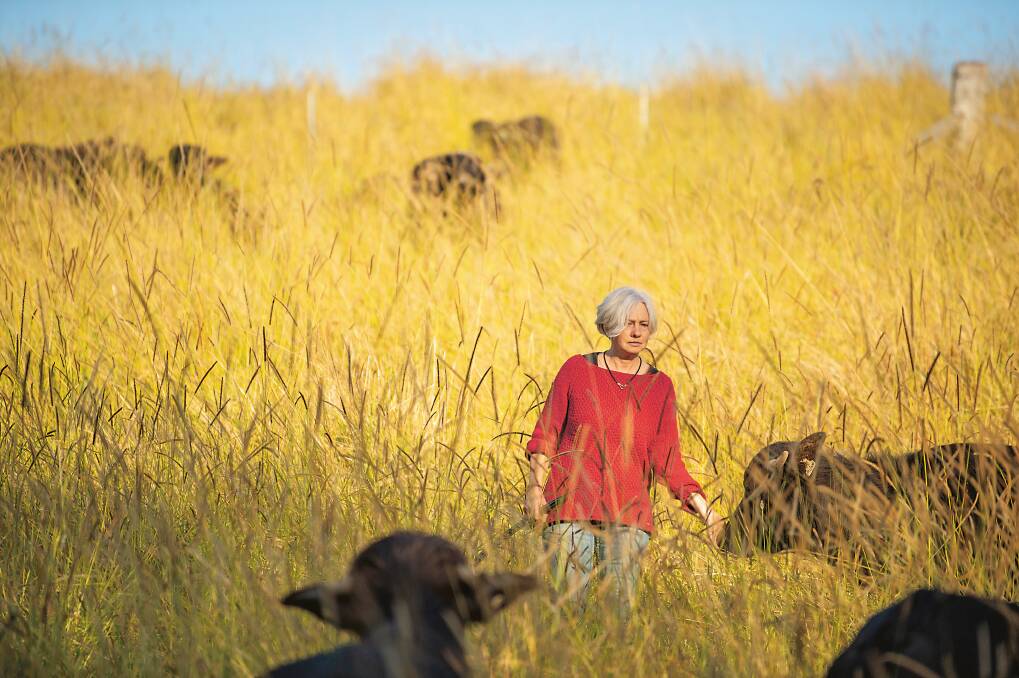
Learning to share buffalo milk
At Burraduc, a regeneratively managed, coastal buffalo dairy farm in the Myall Lakes district of NSW, Elena and Andrei Swegen chose a dairy production model based on the radically different principle of sharing milk with their buffalo calves.
The convention in the intensive dairy model dictates that the new-born calf stays with the cow long enough to receive the colostrum that is crucial for providing antibodies and healthy gut bacteria, after which the two are separated so that the cow can give all her milk to the farmer. By contrast, at Burraduc, the buffalo calves aren't weaned until they are 5-6 months old.
Each morning, the buffalo cows walk from the paddock through the on-farm dairy gate to be milked, after which they spend the day with their calves, feeding and ranging together across the paddocks.
In the evening, they wander back to the dairy with the calves in tow and allow their babies to be separated and placed into a separate pen together while the cows return to spend the night in the paddocks.
In the morning, the cows turn up again for milking and, after giving the farmer a share of their milk, they are reunited with their calves and wander the farm for the rest of the day.
Male calves grow alongside their sisters until they begin to display sexual behaviour at around six to seven months, at which point they are sent off to the abattoir and become buffalo veal, which is consumed on the farm and sold to Burraduc customers.
It's absolutely true that this system of sharing milk results in lower volumes of dairy products for sale and, if you're producing less volume, then the market value of what you do sell must be high for the business to survive.
Which, as always, brings us back to the question of how any one of us measures value - simply by price? Or should we be incorporating environmental, human and animal welfare impact and the nutritional value of a product into the shelf price?
However you choose to answer those questions, at Burraduc, the sharing model produces undeniably successful outcomes.
The pastures are abundant, the calves are well-fed and healthy, the buffalo cows are content and living as naturally as possible, their milk is a rich expression of all the genetic and environmental goodness available on the farm and, in Elena's skilful hands, it becomes award-winning cheese, passing all those minerals and vitamins - the concentrated health and vitality of the farm - to us.
Recipes
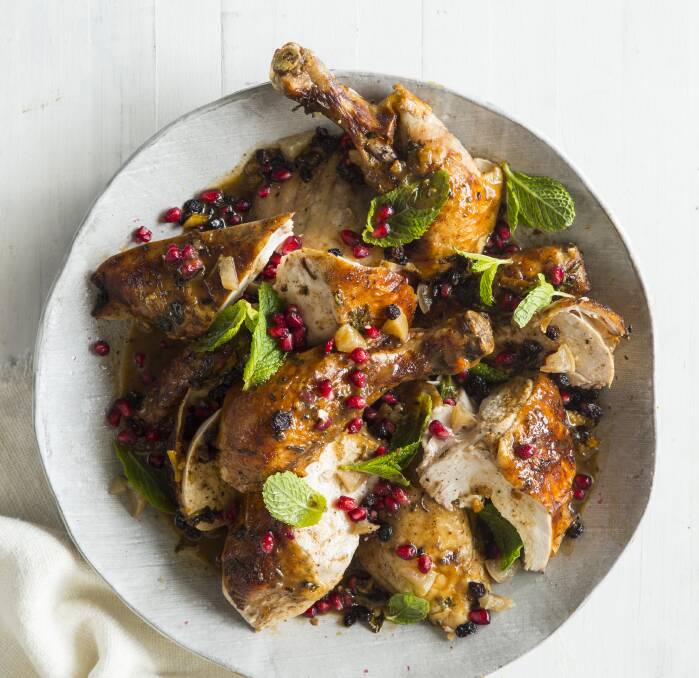
Katie's orange blossom Moroccan-spiced chicken
"I started my food career in the late 1970s, as a cadet journalist in the test kitchen of Woman's Day magazine, under the excellent guidance of cooking legend Margaret Fulton. I went on to have a catering business in the 1980s, and after a long stint as a magazine food editor I now make Katie Swift Cordials for cafes, restaurants and bars. I am very proud to have my cordial at Feather and Bone. I believe it is imperative to know where one's meat has come from, and that it has been sustainably produced and the animal humanely treated. This chicken recipe is based on one published by Karen Martini about a decade or so ago. I love all the flavours and it has become a strong favourite at family lunches."
- Katie Swift, retail customer and producer
Ingredients
80g raw almonds
1 large (about 2 kg pasture-raised chicken
3 tbsp olive oil
1-2 garlic cloves, crushed
1 tbsp Herbie's Spices ras el hanout or other high-quality Moroccan spice blend
1 tbsp orange blossom water
1 tbsp pomegranate molasses
finely grated zest and juice of 1 lemon
2 handfuls coriander leaves, coarsely chopped
2 tbsp Bitton Orange Jelly, or your favourite bitter orange marmalade
75g currants
50g coarsely chopped mint
seeds of 1 pomegranate
75g coarsely chopped preserved lemon rind
Method
1. Preheat oven to 180C. Place almonds on a baking tray and toast for 5 minutes, or until lightly golden. Remove from oven and coarsely chop.
2. Dry chicken inside and out with paper towel, and place on a wire rack set in a roasting tin. Combine olive oil, garlic, ras el hanout, orange blossom water, pomegranate molasses, lemon zest, half the lemon juice and half the coriander.
3. Rub chicken all over with oil and spice mix, place in oven and roast, basting twice, for one hour to 75 minutes or until the juices run clear when a thigh is pierced with a skewer. Remove chicken from oven, transfer to a plate to rest, and pour roasting juices into a saucepan.
4. Add orange jelly to juices in pan, place over medium heat, and cook for 5-10 minutes or until reduced by half. Remove from heat and add remaining lemon juice.
5. Carve chicken into pieces and arrange on serving platter. Pour orange sauce over chicken, then scatter with almonds, currants, mint, remaining coriander, pomegranate seeds and preserved lemon. Serve with couscous, brown rice or crispy potatoes and a salad of mixed leaves.
Serves 4-6.
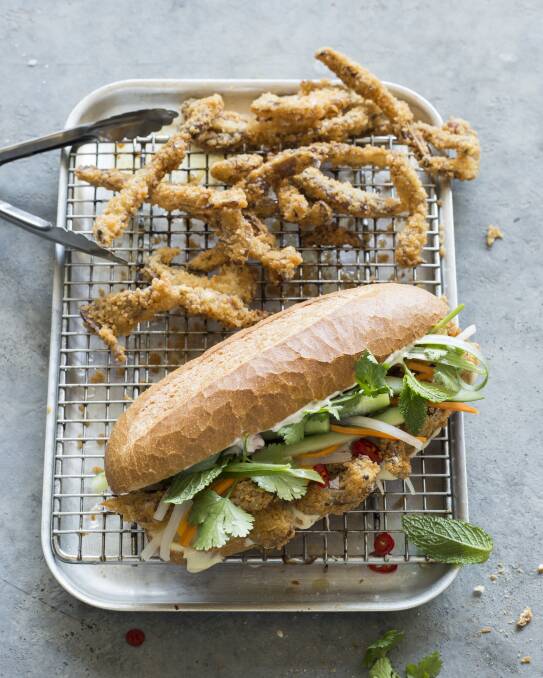
Tammi's crispy pig's ear banh mi
"When we first started selling our pastured pork, I had only been eating meat for about seven years, after a decade of vegetarianism, and was determined to make use of every part of the animals we raise with such care. And so my crispy pig's ear banh mi was born, of necessity and respect, inspired by regular visits to Vietnam over the years. Banh mi are best when there is a balance of fat, fresh, sweet, sour, salt and spice, all wrapped up in a crispy baguette with a soft centre. These crispy pig's ear banh mi capture that formula perfectly, and also leave room for everyone at the table to self-determine their own ratios of each constituent flavour."
- Tammi Jonas, producer and activist
Ingredients
4 pasture-raised pigs' ears
1 leek, coarsely chopped
3 garlic cloves, lightly crushed, still in skin
50g palm sugar
300ml pasture-raised pork bone broth or chicken stock
200ml Shaoxing rice wine
200ml soy sauce
6 star anise
1 cinnamon stick
3 eggs
plain flour, for dusting
60g panko breadcrumbs
lard or rendered animal fat, for deep-frying
crusty baguette or white rolls, to serve
Fillings:
4-6 fried eggs
freshly made mayonnaise or aoli, to serve
40g lightly pickled carrot
2 cucumbers, cut into batons
long red chilli, coarsely chopped, to taste
coriander leaves, to serve
fish sauce, to serve
Method
1. Start this recipe one to two days ahead. Preheat oven to 120C. Place pigs' ears in an ovenproof dish with leek, garlic, sugar, broth or stock, Shaoxing, soy sauce and spices. Cover with baking paper, seal tightly with foil, and braise for about eight hours, or overnight, until very tender.
2. Place ears on a cooling rack in the fridge to dry out for up to one day. Slice ears into thin strips. Beat eggs in a wide bowl and place flour and breadcrumbs in separate bowls. Dust pigs' ears in flour, shaking off excess, dip in egg, then coat in breadcrumbs. Melt 5cm fat in a deep, heavy-based saucepan until shimmering, then deep-fry ears for 2-3 minutes until crisp and golden. Remove with a slotted spoon and drain on a wire rack.
3. Serve pigs' ears in baguettes or rolls, and offer fried eggs, mayonnaise, pickled carrot, cucumber, chilli, coriander and fish sauce for people to fill as they like. Voilà - a crunchy, salty, sweet, sour, spicy banh mi made with a part of the pig most people wouldn't know what to do with. Uncommonly delicious.
Serves 4-6.
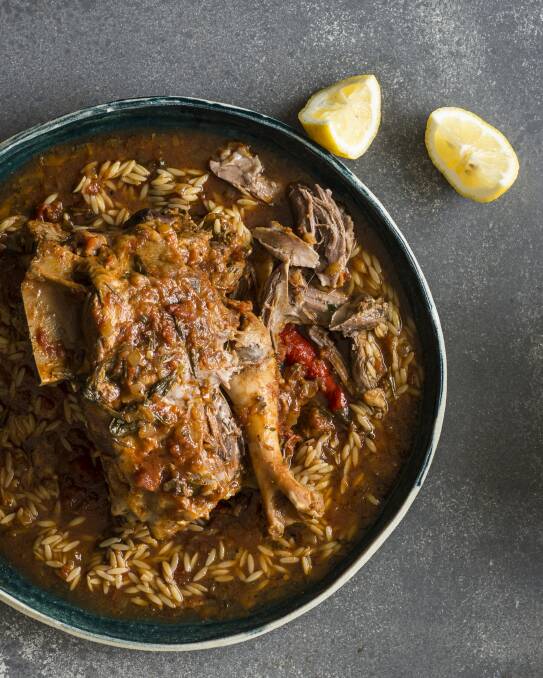
Vince's slow-roasted lamb shoulder with paprika and honey
"I'm the sixth generation to farm our land at Moorlands, near Dalton, NSW and the first to farm biodynamically. We grow award-winning Texel sheep that we've been selling to Feather and Bone since 2011. This is a foolproof dish, inspired by a recipe in Greg and Lucy Malouf's book Moorish, which I've cooked for as long as I can remember. The original recipe uses boned, diced lamb but I love the texture and depth of flavour the shoulder gives to this dish, with the marrow and connective tissue softening into a rich, layered, gelatinous sauce. You just pop it in the oven in the morning before you head off round the farm, check it at morning tea and it's ready in the afternoon."
- Vince Heffernan, producer
Ingredients
2-2.2 kg square-cut lamb shoulder on the bone
1 tbsp olive oil
2 large brown onions, diced
3 garlic cloves, coarsely chopped
1 tsp sweet paprika
finely grated zest and juice of 2 lemons
1 tbsp honey
800g tomatoes, harvested in season and frozen (or use tinned)
1 cinnamon stick
1 handful herbs from the garden (mint, rosemary, thyme, flat-leaf parsley, oregano)
1-1.5 litres chicken stock or water
500g dried risoni or orzo pasta
2 red chillies (optional), coarsely chopped
grilled halloumi, lemon wedges, crusty bread and a green salad, to serve
Method
1. Preheat oven to 100C. Season lamb shoulder with salt and freshly ground black pepper.
2. Heat olive oil in a large cast-iron saucepan over medium heat, add onion and garlic and cook gently, stirring occasionally, for five minutes until softened. Add paprika, lemon zest and honey, and stir to coat. Place seasoned lamb shoulder on top and add tomatoes, cinnamon, lemon juice, herbs and 500ml of stock or water. Bring to the boil.
3. Put lid on and pop it on the bottom shelf of the oven. Let it gently cook for an hour or so, allowing the lamb to release some juices and fat. Take saucepan out of the oven to check and add the rest of the stock or water, pop it back in and leave it for another six hours or so.
4. Half an hour before you're planning to eat, take pan out, and add risoni or orzo and mix well. Return pan to the oven for another 25 minutes or until the pasta is cooked.
5. Serve with grilled haloumi dressed with a squeeze of lemon juice, fresh crusty bread and a crisp green salad.
Serves 8.
- This is an edited extract from The Ethical Omn ivore: A practical guide and 60 nose-to-tail recipes for sustainable meat eating, by Laura Dalrymple and Grant Hilliard. Murdoch Books, $39.99.


